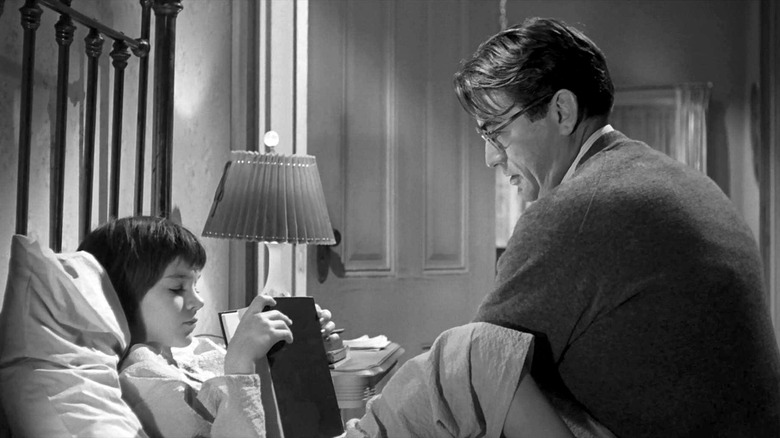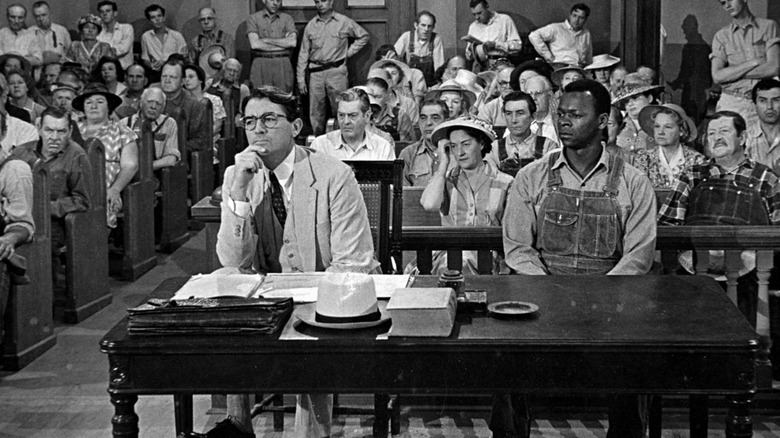Why To Kill A Mockingbird Went A Black And White Route To Adapt The Classic Book
The black and white images of "To Kill a Mockingbird" are seared onto my brain. Just the film's monochrome snapshots of young, rambunctious Scout (Mary Badham, with an uncredited Kim Stanley providing the grown-up Scout's wistful narration) with her friends in the sweltering days of summer — or being scolded for her unkindly manner — are enough to conjure memories of childhood without tipping over into nostalgia.
Compare that to the scenes set at nighttime where Scout and her companions investigate their elusive, reclusive neighbor, Arthur "Boo" Radley (Robert Duvall). These sequences evoke the terror of being a helpless child with their long shadows and sinister ambience, culminating with the film's intense climax (and its profoundly touching aftermath). Even in the movie's agitated courtroom scenes, the black and white visuals serve to augment the fiery emotions on display rather than distract from them.
Director Robert Mulligan's classic 1962 adaptation of Harper Lee's Pulitzer Prize-winner, itself a bildungsroman loosely inspired by Lee's own upbringing, takes place in Jim Crow-era Alabama circa the 1930s. When Scout's father, Atticus Finch (Gregory Peck), proves to be the only lawyer willing to defend Tom Robinson (Brock Peters of "Star Trek" and "Star Wars" fame), a Black man accused of assaulting a white woman, he invites violence from the community upon himself and, in time, his children.
Atticus himself is less of a white savior in his attitude — he'd scoff at anyone who made him out to be a hero — than he is in the way he's perceived. Real-life white folk love to imagine they'd do what he does if they were in his shoes, but many of them would've quietly refused to intervene on Tom's behalf or, in some cases, merely spat in his face like Bob Ewell (James Anderson), had they existed in the story.
This is what makes the film's black and white cinematography so essential.
Black and white was the right choice for To Kill a Mockingbird
In a 1994 interview archived by Front Row Features, Peck explained why the movie was shot in black and white even with the growing popularity of color film at the time of its theatrical release:
"They thought it might be prettified by color, and it would get in the way of the emotions, tension and the human element that was so important. It was an intuition that they had and, since they'd gotten complete control over their movie, they decided to do it. I was all for it."
Indeed, as Peck noted, black and white can have an immensely different psychological effect than color film. Think of how the stunning monochrome visuals in "Schindler's List" lay bare the stark horrors of the Holocaust. Or how the lush black and white imagery of Steven Zaillian's "Ripley" series produce a haunting atmosphere befitting of Patricia Highsmith's noir-flavored thriller.
Just look to Alfred Hitchcock; he'd already directed color films when he made "Psycho" in 1960, but that would've been completely wrong for his tale of the world's worst motel — a movie full of (sort of) haunted houses, stormy nights, and low-key lighting right out of a gothic monster flick.
"To Kill a Mockingbird" is not the be-all, end-all American story on racism some like to make it out to be; its place in the tradition of white savior narratives is too complicated for that. And yet, it remains a powerful coming of age saga about growing up and realizing just how much the adult world is governed by prejudice, some of which we've already absorbed at a young age and must unlearn. That's a sobering message that has, sadly, lost none of its relevancy over time and benefits from an equally unglamorized color palette. To diminish that by colorizing the film is a sin unto itself.

